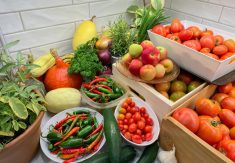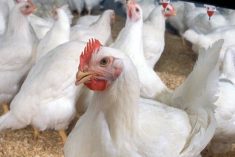U. S. food prices are still headed for their largest increase in two decades this year despite the recent slide in oil and grain markets, the U. S. Agriculture Department said Oct. 18.
In its monthly report, USDA did not change its forecast for food prices, which are expected to surge by 5.5 per cent in 2008 and 4.5 per cent next year. It would be the third year in a row when food prices rose by at least four per cent.
Poultry estimates for 2008 were revised higher due to an increase of 4.5 per cent and fruits and vegetables seven per cent, both up a half per cent from the September estimate. Consumers spend 8.4 cents of each food dollar on fruits and vegetables and 2.3 cents on poultry.
Read Also

Sharing stories to promote Canadian farm safety
Personal stories can sometimes go farther than facts and data to promote safe practices on Canadian farms, Canadian Agricultural Safety Association conference attendees hear.
USDA said the remaining price forecasts by food categories are unchanged from the prior month in both 2008 and 2009. This year alone meats, poultry and fish are forecast to rise 3.5 per cent, eggs 14 per cent and dairy products 8.5 per cent.
USDA economist Ephraim Leibtag, who prepared the forecast, said there were no changes in the 2009 estimate because it’s “too early to tell where commodity prices will end up.”
Food prices have soared during the last year led by wild swings in the commodity market and energy costs that are passed on to consumers.
As worries about a global recession escalate, commodity prices, which reached record highs earlier this year, have plunged. The drop, however, has failed to show up on grocery store shelves.
Mid-month wheat prices fell to a 16-month low of $5.43 a bushel, soybeans neared a 14-month low of $8.25 a bushel, and corn dropped to $3.71 a bushel, marking its lowest point in almost a year.
The cost of energy – used to transport, package and process foods – is still boosting food prices, even though energy prices have dropped significantly. Oil has slumped from a record high above $147 a barrel on July 11 to about $70.
Americans spend more than $1 trillion a year on groceries, snacks, carry-out food and meals in restaurants. Farmers get 20 cents of the food dollar and the rest goes to processing, labour, transportation and distribution.
An informal, 32-state survey of prices conducted in August by the American Farm Bureau Federation found its grocery basket of basics such as milk, bread, cooking oil and ground chuck cost $48.68, up four per cent or $2.01, from May.
In the past 12 months, said AFBF, the cost of its food basket jumped about 10.5 per cent.














